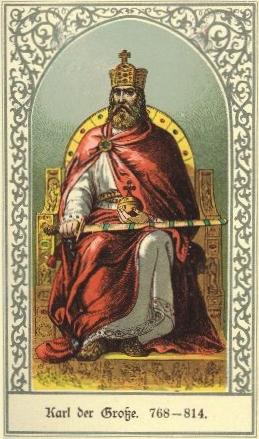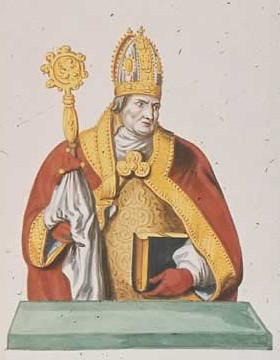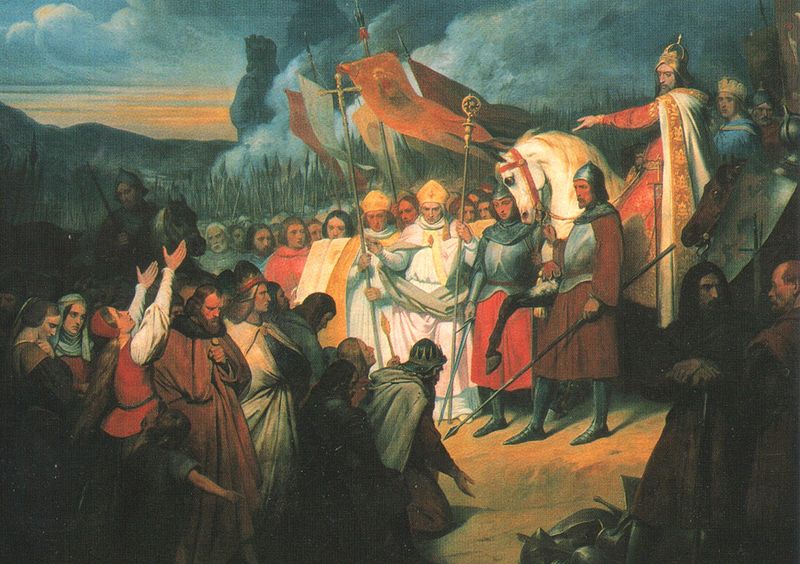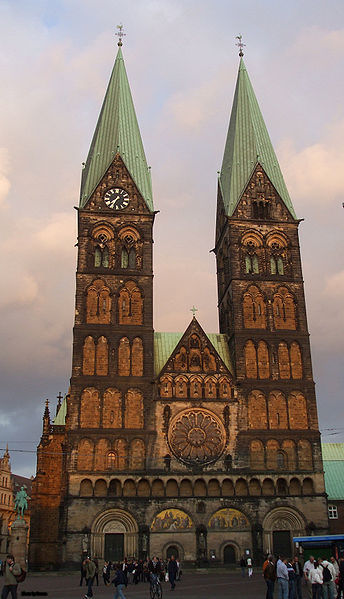by Prof. Plinio Correa de Oliveira
“Saint Willehad, bishop and confessor was the first bishop of Bremen, diocese created by Emperor Charlemagne after his conquests. In the year 788, the 21st of his reign, Charlemagne gave that see a certificate that read: “In the name of our Lord and Savior Jesus Christ, Charles, by the will of Divine Providence, King.
“With the help of the God of hosts we achieved victory in our wars, and from Him alone we received our glory, and it is from Him that we expect happiness and prosperity in this world and an eternal reward in the next.
“Hail to all the faithful of Christ! Hail to all the Saxons saved from their perfidious obstinacy, those who rebelled against our ancestors and who were for a long time rebellious against us and God, until we conquered them not by our strength, but by the strength of the Cross of the Lord.
“From His mercy did we receive the grace of Baptism, which we brought to them, offering them liberty and releasing them from all tributes they owed us. For the love of the One who gave us the victory, we declared them our subjects.
“Since they refused that gift and the yoke of our power, they were defeated by our arms and by the Faith. From now on, they are obliged to pay to Our Lord Jesus Christ and His priests a tithe of all their animals, fruits and crops.”
 This text does not lend itself to a comment about St. Willehad because it simply says that he was bishop of Bremen and then mentions Charlemagne’s decree establishing the Bremen diocese in the year 788, so we are obliged to comment about the decree.
This text does not lend itself to a comment about St. Willehad because it simply says that he was bishop of Bremen and then mentions Charlemagne’s decree establishing the Bremen diocese in the year 788, so we are obliged to comment about the decree.
It seems a bit extravagant to do a Saint of the Day about a decree. If one reads a decree today one finds nothing to make a ‘Saint of the Day’ with. Take, for example, a decree on traffic regulations, or one – like the one here – creating a new tax. What can that have to do with the spiritual life?
What is interesting for us here is to compare the two decrees so that we can see the complete change of ambience from Christian civilization to the civilization of our days.
Here the emperor specifies the ways in which the tribute must be paid to the Church and makes it obligatory.
In this mural painting in the city hall of Bremen, Charlemagne and St. Willehad flank the Cathedral of Bremen as it appeared c1532
It is interesting to note the close relationships between the civil and ecclesiastical powers at that time, the care the civil power took of the ecclesiastical power, and how the former abundantly provided for the maintenance of the clergy, the worship and the Cathedral of Bremen, first of all for the glory of God and then for the Christianization of those semi-pagan peoples.
Another interesting point is how the emperor describes his own role in enacting the tribute. He shows that the Saxons, a pagan people, were conquered by his arms and he has a right of conquest upon them. He had a legitimate right of conquest because the Saxons were very aggressive and continuously invaded the lands of the Franks, whose king was Charlemagne. They also made provocations, carrying out lootings and crimes in cities along the borders, and seeking to impose their pagan religion on the local people.
So Charlemagne went on a crusade in defense of the Catholic religion, invaded their lands and defeated them. He later went overboard by establishing the principle “believe or die” – those who refused to be baptized, were killed. Naturally, the number of baptisms was huge, and so was that of capital executions. On the occasion, there flowed torrents of baptismal water and blood.
He was even censured by the Pope because one may not place anyone in a “believe or die” dilemma. I agree with the Pope and not with Charlemagne. So my next comment should not be seen as siding with the Emperor. But many of those forced baptisms ended well, and the descendants of those families remained and persevered in the Catholic faith even to this day.
Painting by Ary Scheffer of Charlemagne after the battle in Paderborn.
In other words, perhaps it was not entirely licit – better, it was not licit – and therefore it was not good. But to say it was not useful is a different matter. It did produce some fruits.
Charlemagne goes on to show how the Saxons revolted against him again and he had to reconquer them. These peoples thus lived from his mercy, because he could have exterminated them. They were intractable, impossible to live with, and so according to the laws of war he could have reduced them to slavery or killed them. But he did not do that. He consolidated his fortresses, intensified Christianization, and also enacted a stiff tribute on them because they were defeated rebels. And a defeated rebel must pay a higher tax.
* The tax tempers justice with mercy
One sees how Charlemagne knew how to balance justice with mercy. He showed mercy to those people on various occasions, but when the time for justice came, he rightly enacted a tax.
Painting by Karl von Blaas
I said he could have exterminated them. Of course he could not slaughter the whole people, but he could order those arrested with arms in their hands to be killed in order to intimidate the others as a dissuasive measure.
But he was benign and did not take things that far. On the contrary, he put God first by imposing a tax to provide for the Church and the clergy and divine worship. But in fact the people were those who benefited the most. In fact, by establishing the one true Religion in a situation of prestige, supported by the temporal power and endowed with means to influence, the Church took roots among the Saxons and, in time, led them from the state of Barbarianism to the zenith of culture and civilization: Germany.
So you see how Charlemagne was wise and good in his policies, something that comes through more or less clearly in the decree.
 It is beautiful to note how the emperor attributed all those victories to God: “We won through the grace and with the help of God.” As if saying, I know I won this battle, but I was but an instrument, and if it were not for God’s intervention I would have lost.”
It is beautiful to note how the emperor attributed all those victories to God: “We won through the grace and with the help of God.” As if saying, I know I won this battle, but I was but an instrument, and if it were not for God’s intervention I would have lost.”
The mission of Charlemagne in history before the pagan peoples; his role as distributor of justice and mercy in God’s name in the temporal order, and as the right arm of the Church in the temporal order – all these ideas are contained in the first words of the decree: “In the name of Our Lord and Savior Jesus Christ, Charles, by the will of Divine Providence, King.”
This is something of extraordinary beauty. One has the impression that this title’s proclamation causes many angels to sing, cathedral bells to ring, and heavenly lights to shine. What it means, is that Charlemagne understood perfectly that all his power came from on high. He was king because Divine Providence wanted him to be God’s representative in the temporal sphere and to serve the Holy Mother Church in all things that she might require in the temporal order.
The reason this title shines so much is its sacrality, that is, a preexisting design of divine Providence that gives meaning and foundation to everything. And so one understands the beauty of this decree.
* Saint Willehad: a flower in the vase
Now, what do these comments have to do with St. Willehad’s life? A whole lot, I think, for all those endeavors by Charlemagne fit St. Willehad like a vase fits a flower. Take a magnificent vase, made to hold a flower; as long as a flower is not put into it, the vase remains like an orphan. The vase only attains its purpose and full beauty when a flower (even more beautiful than it) is placed in it. When that happens, the beauty of nature – a direct work of God – somehow outdoes the beautiful object that man made to hold that flower, a masterpiece of nature.
St. Willehad is the flower in the vase. What good would be that great cathedral and diocese, and that great emperor if a true saint had never been appointed to head the place? If the perfume and leaven of St. Willehad’s sanctity had not spread among the Saxon people? All these material things are beautiful and noble. They all follow a design of Divine Providence to the degree that they spread the influence of sanctity and serve as instruments for sanctity. Sanctity is the true life in all this.
Bremen Cathedral
Thus, we can imagine St. Willehad in Bremen in his new cathedral, with rows of converted Saxons lining up to pay their tithe to properly maintain the cathedral and divine worship. We can imagine the people singing in the cathedral. We can imagine, reigning in his episcopal chair, St. Willehad representing God even more than Charlemagne himself, as he was both a bishop and a saint.
So you understand the role of St. Willehad in his cathedral in that early stage of Christendom, in that ambience prepared by the zeal of Charlemagne. St. Willehad was the flower from whence came the perfume and the charm of the supernatural life of grace for all those people.
The Saint of the Day started thus: Charles, by divine will and by design of Providence, King. And ends: St. Willehad, by the will and design of Divine Providence, bishop and saint. It begins with a king and ends with a saint. Here is the Middle Ages in all its splendor.
I – Charlemagne
1. The whole decree is founded on the paternal character of power.
2. The premises are all religious: notion of Catholic State in which the Law of God is the foundation of morals and the foundation of State laws.
3. Relations of Charlemagne with the defeated Saxons:
a) The Christian winner, victorious crusader who, in a war of legitimate self-defense, defeats and punishes the aggressive pagan people seeking to destroy the Church.
b) The emperor’s mercy after the first victory and the ingratitude of revolted Saxons.
c) The tax, a just and severe pnishment.
d) The first meaning of the tax: the revolted pagan owes a tribute to Our Lord Jesus Christ who is the offended Victor.
e) Advantage for the defeated people in being Christianized and civilized: utility of the cathedral for that end.
f) Second meaning of the tax: making reparation and helping build the cathedral.
Bremen in the 16th century. Oldest preserved view of the city of Bremen. Woodcut by Hans Weigel
4. The emperor’s role as an instrument of the spiritual power: his law imposes on Saxons the way they must fulfill the divine precept of maintaing divine worship.
5. Charlemagne’s title as King contains all these concepts: In the name of Our Lord and Savior Jesus Christ, Charles, by will of the Divine Providence, King!
6. Charlemagne’s spirit of faith in recognizing that God is the main winner, while he is only an instrument.
II – Saint Willehad, first Bishop of Bremen, the city to which the decree refers.
1. The saint was the cathedral’s greatest treasure:
a) as a bishop, anointed by God with the fullness of the priesthood.
b) as a saint.
2. All the material things we mentioned existed for him like a vase for a flower.
III – Overall view
1. Charlemagne, the profoundly Catholic crusader, emperor of immortal glory, venerated in some places as saint and a blessed.
2. The bishop saint.
Together, they form a diptych that shows all the splendor of the Middle Ages.
These commentaries are drawn and adapted from a talk given by the author on November 8, 1971. He was not able to review them prior to this publication.








No comments:
Post a Comment